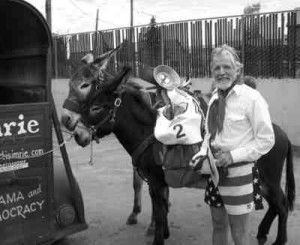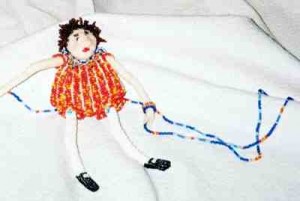Column by George Sibley
Environment – May 2008 – Colorado Central Magazine
Perhaps the difference between carbon man and the silicon devices he is creating is like the relationship between the caterpillar and the iridescent, winged creature that the caterpillar unconsciously prepares to be.
— O. B. Hardison, Jr., “Disappearing through the Skylight”
IT’S “EARTH HOUR 2008,” as I start this. The house is dark except for three lights. One is the orange flicker of a fire in the heating stove, whose glass door is the closest thing to television in our living room. In the winter my partner and I dine from TV trays in front of the stove, watching the fire, but we can still talk since the stove lacks the TV’s noise problem.
The second light is the yellowish light from a hurricane lamp we keep around for emergencies, or sometimes for its romantic æsthetics. But I’ve just learned that it’s not a very good reading light.
And that leads to the third light. The third light is the cold brilliant light of my laptop screen. On battery, not plugged in, although I suppose that’s still cheating in “Earth Hour.” But just sitting here, “carbon man,” in the flickering light of my other two carbon light sources, I was struck by a thought I am now trying to chase down in words, and I reflexively went for the laptop. Fitting, since it’s a thought that involves the laptop.
The thought begins with the idea of Earth Hour, which is to remind us of something we should be doing but aren’t yet, at least not at the scale needed, and that’s reducing our “carbon buttprint” to a shadow of its current size. Ten percent carbon emission reduction by 2010, 20 percent by 2020 — 80 percent by 2050? Now we have reputable scientists saying that 100 percent reduction by 2050 ought to be our goal, but even that might not be enough to stop what is already in motion, in terms of global climate changes. Meanwhile, since Kyoto, global carbon emissions have gone up 13 percent.
But I’m wondering if Earth Hour might be counterproductive, in terms of waking us to that task. It reminds me of a scene from one of our “Gunnison Sonofagunn” spoofs; after an environmentalist lectures the rest of the cast on their consumptive ways, someone asks what he would do instead.
“I,” he proclaimed virtuously, “sit in the dark and freeze.”
I was neither freezing nor in serious darkness. But do I want “Earth Hour” forever? No, and neither does anyone with any love for life. Earth Hour was about giving up life as we know it for an easy hour; the real challenge is figuring out what we will do when it’s Earth Hour all day every day. Are we just going to sit in the semidark, wearing an extra sweater and being virtuous?
And that’s where my computer comes in. And my library: I have enough books waiting to be read, to finish out my life — and should I outlive my own library, there’s a public library two blocks away; even if they never got another book, I could fill another whole life there. What I’m saying is: If we truly get serious about this carbon-reduction business, what I will do is retreat into my mind, and be reasonably happy. Or, should I say, advance into my mind?
This is where my computer comes in. I’m on my ninth computer now, but its silicon guts carry forward the evolution of my mind. It’s all there, everything I have thought and re-thought for the past twenty-some years — all of it except for the wild summoning spiritual energy that is the only reason for keeping my deteriorating carbon brain alive — and the parts of my mind that I keep in the computer are much more organized and ordered than I was ever able to manage in my pre-computer “carbon brain.”
What am I talking about? Let me jump to a column I read in the Sunday Denver Post March 30: “Put down the Remote. Now.” Writer Jeff Osgood was reflecting on recent studies that show attendance dropping in our national parks and national forests: fewer visitors, campers, people getting out to mingle with the natural. Osgood cited a University of Illinois study that offered two reasons. One, predictably, is the rising cost of fossil fuels and its effect on travel — a cost that will increase even more dramatically in the future.
THE SECOND REASON is what the researchers called “videophilia”: the growing preference people seem to be developing for watching vicarious outdoor experiences as opposed to sweating and slogging through the real thing. This seems reinforced by an article in the April Mountain Gazette about the proliferation of mountain-town festivals featuring nature and adventure films — mountain folk sitting in dark theaters to watch “ecorotic” distillations of experiences they could seek themselves just beyond their own town limits.
Osgood virtuously thinks of this as a bad thing: we’re turning into a nation of screen potatoes, lumps of carbon-based life staring at siliconized images. But there is another way to look at it. Which is better for reducing our carbon buttprint? A theaterful of people watching some heroic conquest of nature, or that same bunch of people all hopping into their cars, loaded with bikes and kayaks and packs and camping gear, all heading out to conquer nature firsthand? For that matter, which is better for nature? There’s a good ecological argument for listening to the psalmist — to “lift up our eyes unto the hills” without feeling compelled to drag our butts up there too, with the substantial ecological buttprint that accompanies the adventure.
I don’t want to go overboard here. I love to hike; I love getting a little lost, and feel best about a big hike when I come home with my legs and arms all scratched and a mild sunburn from sweating off my sunscreen. Dragging my butt up the hills recharges my mind. But I may owe it to the hills, to nature, to spend at least as much time “advancing into my mind,” downloading the carbon-world experience — what Wordsworth called “the passionate moment recollected in tranquility” — into my evolving “silicon mind.” And that’s where the computer comes in; it’s the mirror of my mind, and Googling through that looking-glass, I tap into the world-mind.
AT THIS POINT In my life, if I had to choose — and I believe the 21st century is going to be about “choosing” rather than “you can have it all” — why wouldn’t I choose the culture evolving through the silicon chip over the culture evolved around carbon fuels? Wouldn’t it be easier to maintain our computers and the Internet, than our autos (increasingly computerized anyway) and the highway system? Next summer I’m going to install enough solar capacity to keep our computers charged up, and maybe a couple of LED lights — and dig a root cellar, expand the garden. I can live on homegrown potatoes and wood heat with extra sweaters if I can continue to advance into my mind.
I’m intrigued by thinkers like O. B. Hardison (see quote at beginning). He’s a humanist, not a scientist, who suggests that we are evolving beyond what he calls “carbon life,” to “silicon life” — leaving our needy carbon bodies behind and encoding ourselves on chips and drives that are developing the capacity to maintain and repair themselves. And thus we may eventually take that final step beyond just organizing and filling our minds at work, and will begin to take over the synaptic dances that put together memory and random imaginings into something new and creative — something more truly us as we imagine we could be….
Could I live as just a mind, shedding the carbon sheath with its needs for heat, food, water, sex, transportation?
I think of Voyager 1, now on its quiet voyage out in the absolute outer reaches of our star’s area of influence. This should be our great modern myth, sending this manifestation of pure mind, silicon life that needs only minute quantities of heat to survive, moving out in search of intelligent life in the universe — with the implicit question, whether we earthbound carbon beings, driven by needy stomachs, lungs, penises, egos, can really be considered intelligent life.
But then, on the other hand, there’s the hike, the feel of legs under one (gimpy knee notwithstanding), the functional hand that turns the paper pages under the yellow light or feels warmth in the night, the eye’s fascination with the stove TV, the untrained but enthusiastic carboniferous voice, smoothed and buoyed with the fruit of the vine, that tries to sing along with my partner as she plays sappy old carbon-era songs on the old wood piano, and all the many other pricey but priceless joys of carbon life.
So, just another earth hour. I don’t know. Does the butterfly happen, whether the caterpillar imagines it or not?
George Sibley writes from Gunnison, where spring is becoming a possibility.


